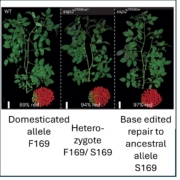Splicing factor represses rice tillering by stabilizing strigolactone signal transmission
By Tianzhen Liu, Qibin Lin
National Key Facility for Crop Gene Resources and Genetic Improvement, Institute of
Crop Sciences, Chinese Academy of Agricultural Sciences, Beijing 100081, China
Background: Rice is one of the staple crops in the world, feeding more than half of the world’s population. Plant height, tiller number and panicle morphology, which are controlled by complex genetic networks, are important factors that affect plant architecture and determine rice grain yield. Strigolactones constitute a class of plant hormones that regulate many aspects of plant development, including repressing tillering in rice. However, how the strigolactone pathway is regulated is still poorly understood.
Question: We wanted to know if there are any unknown mechanisms involved in the regulation of strigolactone signaling. By a forward genetic approach, we identified a rice dwarf and high tillering 1 (dht1) mutant defective in strigolactone signaling and wanted to know the detailed role of DHT1 gene in regulating strigolactone signaling.
 Findings: We found that dht1 exhibits similar pleiotropic phenotypes to mutant defective in strigolactone signaling. We showed that DHT1 encodes a monocotyledon-specific hnRNP-like protein localized in the nuclear speckle. We found that DHT1, as a component of the core splicing factor U1 snRNP, cooperates with various SR proteins to regulate the intron splicing of pre-mRNA of many genes. Interestingly, we found that DHT1 regulates the pre-mRNA splicing of the strigolactone receptor gene D14. Furthermore, the DHT1I232F mutant protein is impaired in its stability and RNA binding activity, causing defective splicing of D14 pre-mRNA and reduced D14 expression, and consequently leading to the strigolactone signaling-defective phenotypes. Overall, our findings reveal a connection between posttranscriptional splicing and strigolactone signaling in regulating plant development.
Findings: We found that dht1 exhibits similar pleiotropic phenotypes to mutant defective in strigolactone signaling. We showed that DHT1 encodes a monocotyledon-specific hnRNP-like protein localized in the nuclear speckle. We found that DHT1, as a component of the core splicing factor U1 snRNP, cooperates with various SR proteins to regulate the intron splicing of pre-mRNA of many genes. Interestingly, we found that DHT1 regulates the pre-mRNA splicing of the strigolactone receptor gene D14. Furthermore, the DHT1I232F mutant protein is impaired in its stability and RNA binding activity, causing defective splicing of D14 pre-mRNA and reduced D14 expression, and consequently leading to the strigolactone signaling-defective phenotypes. Overall, our findings reveal a connection between posttranscriptional splicing and strigolactone signaling in regulating plant development.
Next steps: DHT1 regulates rice architecture as an important splicing factor. Moreover, DHT1 has many target genes involved in multiple development processes of plants. The coupling mechanism between the splicing machinery and these plant development processes should be studied in future.
Tianzhen Liu1,†, Xin Zhang1,†, Huan Zhang2,†, Zhijun Cheng1,†, Jun Liu1, Chunlei Zhou2, Sheng Luo1, Weifeng Luo1, Shuai Li1, Xinxin Xing1, Yanqi Chang1, Cuilan Shi1, Yulong Ren1, Shanshan Zhu1, Cailin Lei1, Xiuping Guo1, Jie Wang1, Zhichao Zhao1, Haiyang Wang1, Huqu Zhai1, Qibing Lin1* and Jianmin Wan. (2022). Dwarf and High Tillering1 represses rice tillering through mediating the splicing of D14 pre-mRNA. Plant Cell. https://doi.org/10.1093/plcell/koac169.






